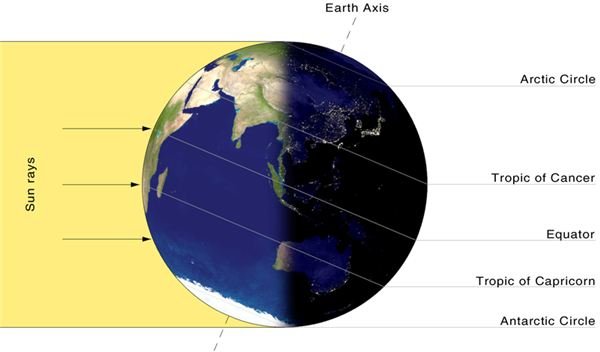The Winter Solstice Celebration Explored: Elementary Lesson Plan for Winter Solstice Traditions
Lesson Objective
Students will explore the winter solstice. They will discover that the traditional holiday is astronomically based and learn what this means. They will discover the scientific and seasonal significance of this event, traditional rituals and customs.
Preparation
Teacher should have a model, either photos or a 3D version, of the sun and earth.Teacher should have books and stories about the winter solstice.
Timeline
Three class periods (50 minutes each)
Procedure:
Begin the class with asking the students if they know what the winter solstice is. Record any ideas that they may have about this traditional celebration.
Start to talk to the class about the change of seasons, how days become shorter and nights become longer in the winter. Many people believe that seasons occur due to how far away the Earth is from the sun. However, what really causes seasons is the way the Earth is tilted. Earth rotates around its axis, which is slanted instead of straight up and down. We experience winter in the Northern hemisphere during the time that the North end of Earth is tilted away from the sun, and the Southern end is tiled towards the sun. The opposite is true when the Norther hemisphere experiences Summer.
Show the students northern hemisphere and southern hemisphere on your model or globe. Explain that the winter solstice in the Northern Hemisphere occurs between December 20 – 23 and in the Southern Hemisphere this occurs between June 20 – 23.
Talk about why it occurs at different times of year for the two hemispheres (location from the sun), using planet models to illustrate. At this time you can also show your students photos, books, magazine and online sites demonstrating the way the Earth moves around the sun and how it’s axis is tilted.
Discuss with the students the length of days. Are they getting longer (more sun) or shorter (less sun)? Why do they get longer and shorter?
The winter solstice has seasonal significance because on this day the reversal of long nights and short days begins. Days get longer and nights start getting shorter after this day. The winter solstice is the longest night and shortest day of the year.
The Winter solstice was often a time of celebration for many ancient civilizations. Why would this be an important day for ancient people?
- Discussion should include how important changes in weather were to ancient societies. Not only did this signal another year of life, it was also crucial to know weather patterns to plan for appropriate shelter and food storage.
Show a picture and explain to the class that on this night the three stars in Orion’s belt align with the brightest star (Sirius) and these alignment shows where the sun will rise the next morning. Ask your students to test this during this year’s winter solstice.
Discuss how the winter solstice signifies rebirth and a return to light to ancient people. Emphasize this transition from dark to light, and themes of rebirth. Discuss how Stonehenge was designed and constructed based upon this holiday. Use books, magazines or have students break into groups and research this.
Wrap-Up
In conclusion read the class a book or story about the winter solstice. Also read about traditions and rituals that are practiced during the winter solstice celebration.
Suggested Books:
-
The Return of the Light by Carolyn McVickar Edwards
-
The Shortest Day: Celebrating the Winter Solstice by Wendy Pfeffer, Jesse Reisch (Illustrator).
-
The Fires of Yule: A Keltelven Guide for Celebrating the Winter Solstice by Montague Whitsel
Extension:
Ask students to research and share with the class some traditional customs associated with the winter solstice. There are 36 different cultural celebrations associated with the winter solstice. Have your students investigate a few of these and share with the class.
References
- Photo under Creative Commons license via Wikimedia Commons.
- What causes the seasons? http://spaceplace.nasa.gov/seasons/en/
